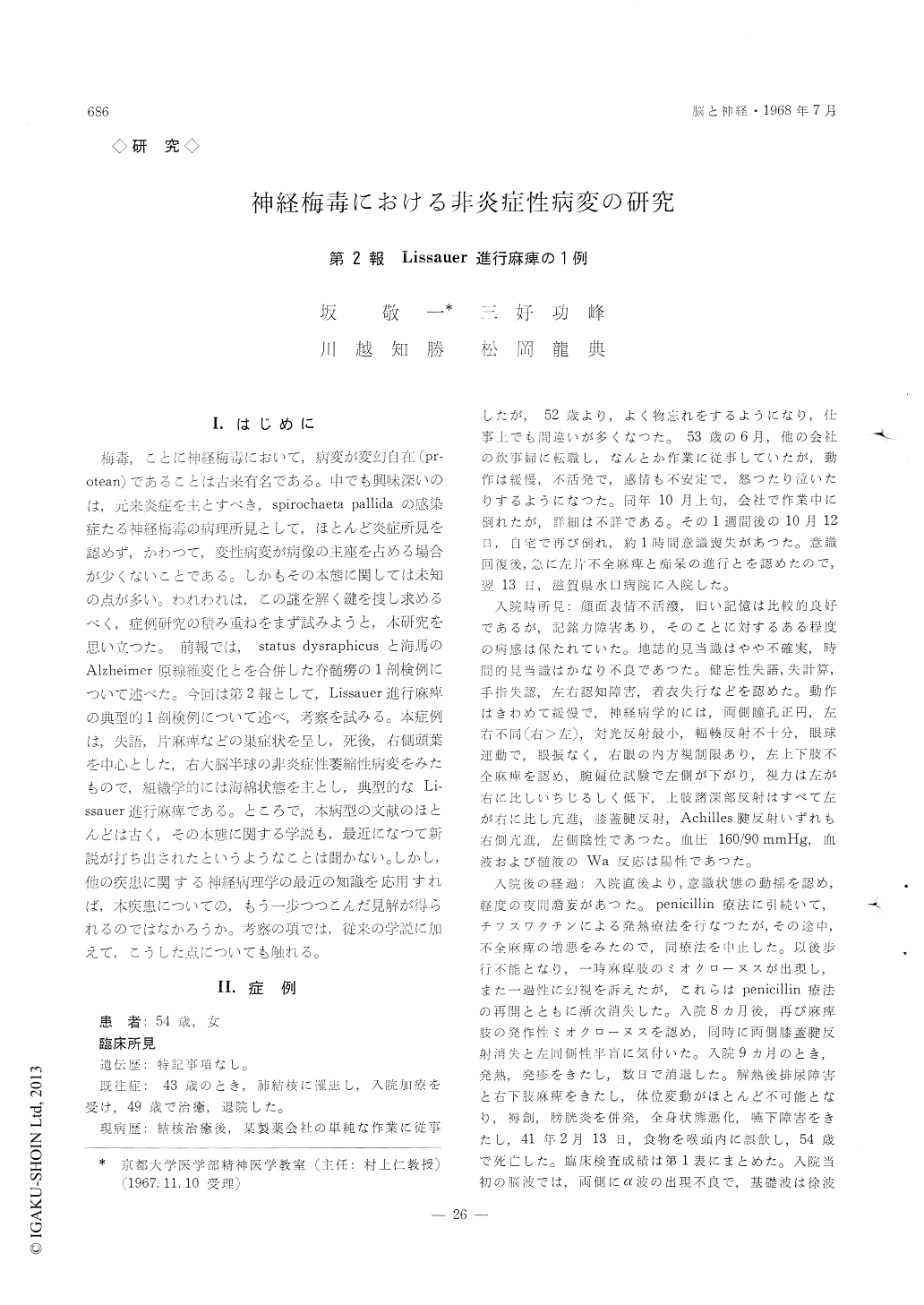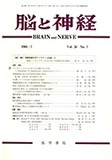Japanese
English
- 有料閲覧
- Abstract 文献概要
- 1ページ目 Look Inside
I.はじめに
梅毒,ことに神経梅毒において,病変が変幻自在(pr—otean)であることは古来有名である。中でも興味深いのは,元来炎症を主とすべき,spirochaeta pallidaの感染症たる神経梅毒の病理所見として,ほとんど炎症所見を認めず,かわつて,変性病変が病像の主座を占める場合が少くないことである。しかもその本態に関しては未知の点が多い。われわれは,この謎を解く鍵を捜し求めるべく,症例研究の積み重ねをまず試みようと,本研究を思い立つた。前報では,status dysraphicusと海馬のAlzheimer原線維変化とを合併した脊髄癆の1剖検例について述べた。今回は第2報として,Lissauer進行麻痺の典型的1剖検例について述べ,考察を試みる。本症例は,失語,片麻痺などの巣症状を呈し,死後,右側頭葉を中心とした,右大脳半球の非炎症性萎縮性病変をみたもので,組織学的には海綿状態を主とし,典型的なLi—ssauer進行麻痺である。ところで,本病型の文献のほとんどは古く,その本態に関する学説も,最近になつて新説が打ち出されたというようなことは聞かない。しかし,他の疾患に関する神経病理学の最近の知識を応用すれば,本疾患についての,もう一歩つつこんだ見解が得られるのではなかろうか。考察の項では,従来の学説に加えて,こうした点についても触れる。
History : A 53-year-old woman was admitted to the Minakuchi Hospital in Shiga on October, 1965. As a previous illness she had lung tuberculosis for several years from the age of 43. After the recovary she engaged with a simple task in a manufactory. From the age of 53 on, she became amnestic, when her present illness seemed to start. Thereafter, she was bradyphrenic, apathetic and emotionally unsta-ble, the paralytic fits recurred twice with a interval of a week, and the left-sided hemiparesis and abrupt aggravation of dementia succeeded to the last fit, and the next day she was admitted to the hospital. On admission WaR was positive both in blood serum and in CSF. In addition to the above symptoms amnestic aphasia, acalculia, finger agnosia, left-right disturbance and dressing apraxia were found. After admission, she sometimes experienced delirious states. Fever therapy with typhoid vaccine rather worsen the clinical picture. Then, penicillin was adminis-tered. However, the course of illness remained unfavourable, occasionally developing visual halluci-nations as well as myoclonic jerkes on the paretic limbs. From the 9 th hospital month on, decubiti, dysphagia, cystitis and general merasmus developed, and she was expired after an erroneous swallowing of food mass into the trachea, on Februray 13 th, 1966 when she was at the age of 54.
Anatomically, the brain weighed 990 gramms and was asymmetric. The left hemisphere was smaller than the right, and the atrophy was most marked in the areas from the left temporal tip upwards and backwards to the supramarginal and angular gyri, where the tissue was changed to a pseudoulegyric state. Microscopically, inflammatory changes, con-sisted chiefly of perivascular lymphocytic infiltration, were receded into the background, and status spon-giosus predominated the histological picture of the atrophic areas, distributing psudolaminally or dif-fusely in the cortical layers and also patchily in the subcortical white matter, in where fat granule cells and gemistocytic astrocytes were abundant. The secondary degeneration of the left pyramidal and extrapyramidal tracts could be followed up from the level of crus cerebri to the contralateral pyr-amidal tracts of the spinal cord. In discussion pre-viously reported cases of Lissauer's dementia paratica were reviewed in relation to the clinical and patho-logical features of the present case. The patho-genesis of the condition was also discussed in con-nection with those of subacute spongiform encep-halopathy and of post-epileptic lober sclerosis and cerebral hemiatrophy.

Copyright © 1968, Igaku-Shoin Ltd. All rights reserved.


